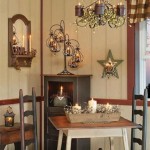How To Decorate A Black Dining Room Table
A black dining room table presents a sophisticated and versatile foundation for a dining space. Its inherent boldness can serve as a striking focal point, but effectively decorating it requires careful consideration of color palettes, textures, and overall design aesthetics. The contrast created by a black surface offers a unique opportunity to create a visually compelling and inviting dining environment. Success depends on understanding how to leverage the table's inherent qualities and complement them with well-chosen decor elements.
Decorating a black dining room table is not merely about placing items on its surface; it encompasses a holistic approach that considers the surrounding room and the desired atmosphere. The style of the room – whether modern, traditional, minimalist, or eclectic – should inform all decorating choices. A heavy ornate centerpiece might clash with a sleek, minimalist space, while a simple candle arrangement could appear underwhelming in a richly decorated, traditional dining room. The goal is to create a cohesive and harmonious design where the table decoration enhances the overall aesthetic.
Before embarking on the decorating process, it is crucial to assess the existing elements of the dining room. Consider the color of the walls, the flooring material, the style of the chairs, and the lighting fixtures. The table decoration should complement and enhance these existing features. For example, if the walls are a light neutral color, darker or more vibrant accessories can create a striking contrast against the black table. Conversely, if the walls are already bold, lighter and more subtle decorative elements might be better suited to avoid overwhelming the space.
Choosing a Color Palette for a Black Dining Table
The selection of a color palette is a critical aspect of decorating a black dining room table. Black is a neutral color that pairs well with a wide range of hues, but the right combination can significantly impact the overall mood and style of the room. One popular approach is to utilize contrasting colors to create visual interest. White, cream, or other light neutral tones paired with black create a classic and elegant look. This combination is particularly well-suited for minimalist or contemporary dining rooms.
Another effective strategy is to incorporate pops of color through accessories. Bright colors, such as red, yellow, or turquoise, can add energy and vibrancy to the space. These colors work exceptionally well as accents in floral arrangements, decorative bowls, or table runners. When using bold colors, it is essential to maintain balance and avoid overwhelming the black table. Spacing out the colors and using them strategically can create a visually appealing and harmonious effect.
For a more subdued and sophisticated look, consider using shades of gray, silver, or gold. These metallic tones complement black beautifully and add a touch of glamour to the dining room. Silver and gold accents can be incorporated through candlesticks, decorative trays, or place settings. This approach is particularly effective for creating a formal or elegant dining atmosphere.
A monochromatic color scheme, using different shades of black and gray, can also be a stylish option for a black dining room table. This creates a sophisticated and modern look that is both understated and elegant. Textural variation becomes crucial in a monochromatic scheme; exploring different materials such as matte and glossy finishes, leather, and natural fibers helps add depth and prevent the design from appearing flat.
Ultimately, the choice of color palette depends on personal preferences and the desired aesthetic for the dining room. Experimentation and careful consideration of how different colors interact with black are key to achieving a visually pleasing and balanced design.
Selecting Complementary Tableware and Linens
The choice of tableware and linens plays a significant role in complementing a black dining room table. These elements are fundamental to the dining experience and also contribute significantly to the overall aesthetic of the table setting. Selecting items that harmonize with the black table and the chosen color palette is essential.
For a formal dining setting, crisp white or ivory linens are a classic choice that creates a sophisticated contrast against the black table. These neutral tones allow the food to take center stage and create a clean and elegant presentation. Linen napkins and placemats add a touch of luxury and refinement. Opting for higher quality, finer fabrics will elevate the overall feel of the dining experience.
For a more casual or contemporary setting, consider using linens with subtle patterns or textures. Geometric designs or natural fibers, such as linen or cotton, can add visual interest without overwhelming the black table. Using placemats in different colors, such as gray, beige, or even a muted color like dusty rose, can add a touch of personality to the table setting. Charger plates can also create a layered and visually appealing look.
The choice of tableware should also complement the black table and the chosen linens. White or cream-colored plates are a versatile option that works well in both formal and casual settings. They provide a blank canvas for the food and create a clean and elegant presentation. Alternatively, consider using tableware with metallic accents, such as gold or silver rims, to add a touch of glamour to the table setting.
Colored glassware can also contribute to the overall aesthetic of the table. Clear glass allows the colors of the drinks to shine through, while colored glass can add a touch of personality and vibrancy. Choose glassware that complements the chosen color palette and the style of the dining room. Consider the shape of the glassware as well; elegant stemmed glasses add refinement, while simpler tumblers are better suited to casual settings.
When selecting tableware and linens, it is important to consider the functionality and practicality of the items. Choose durable materials that are easy to clean and maintain. Also, consider the size and shape of the items to ensure that they are appropriate for the table and the intended use.
Incorporating Centerpieces and Decorative Accents
The centerpiece is the focal point of the dining table and plays a crucial role in setting the overall tone of the dining space. A well-chosen centerpiece can transform a plain table into a visually appealing and inviting setting. When decorating a black dining room table, the centerpiece should complement the table's dark surface and the chosen color palette. The centerpiece should also be proportional to the size of the table, avoiding overcrowding or appearing too small.
Floral arrangements are a classic and versatile centerpiece option. Fresh flowers add color, fragrance, and a touch of nature to the dining room. Choose flowers that complement the chosen color palette and the style of the room. For a formal setting, consider using elegant arrangements with classic flowers, such as roses or lilies. For a more casual setting, wildflowers or greenery can create a relaxed and inviting atmosphere. The vase or container housing the flowers should also complement the overall aesthetic. A sleek glass vase works well in a modern setting, while a rustic ceramic pot may be more appropriate for a farmhouse-style dining room.
Candles are another popular centerpiece option that can add warmth and ambiance to the dining space. Grouping candles of different sizes and shapes can create a visually appealing and romantic atmosphere. Use candlesticks in various materials, such as metal, glass, or wood, to add texture and interest to the table. Scented candles can also add a pleasant fragrance to the room, but choose scents that are not overpowering. Candleholders can add to the ambiance as well; incorporating metallic or glass elements with geometric shapes will add visual interest.
A decorative bowl or tray filled with interesting objects can also serve as a unique and eye-catching centerpiece. Fill the bowl or tray with seasonal items, such as pinecones in the winter or seashells in the summer. You can also use decorative balls, stones, or other natural elements to add texture and visual interest. Ensure the items used are scaled appropriately for the selected bowl and table size. Empty bowls and trays can also be decoratively interesting on their own.
In addition to the centerpiece, decorative accents can be used to enhance the overall aesthetic of the black dining room table. Place cardholders, napkin rings, and other small decorative items can add a touch of elegance and personalization to the table setting. Ensure that the accents complement the chosen color palette and the style of the room. A table runner is another effective way to add color, texture, and visual interest to the table. Choose a runner that complements the chosen linens and the centerpiece. The material can range from silk to burlap, depending on the desired feel.
When incorporating centerpieces and decorative accents, it is important to maintain balance and avoid overcrowding the table. The goal is to create a visually appealing and inviting setting that enhances the dining experience, without overwhelming the space. Consider the height of the centerpiece and accents to ensure that they do not obstruct the view across the table. A low and horizontal arrangement often works best to facilitate conversation and interaction.

Black Dining Room Table Ideas For Your Home Design Cafe

Black Dining Room Table Ideas For Your Home Design Cafe

How To Use Black Create A Stunning Refined Dining Room Decoist

51 Black Dining Room Ideas Photos

13 Reasons Why Black Dining Tables Work In Any Interior

13 Reasons Why Black Dining Tables Work In Any Interior

ᒪoᑌiᔕe Dining Room Design Luxury Black

An Eclectic Dining Room With Unconventional Wall Color

Black Oak Dining Table With Cane Chairs Transitional Living Room

Black Dining Room Color Ideas For Your Consideration Hunker
Related Posts







